
The First and Only Weekly Online Fanzine Devoted to the Life and Works of Edgar Rice Burroughs
Since 1996 ~ Over 15,000 Webpages in Archive
Volume 0827

The ERB Artist Profile Series
REX HAYDEN MAXON
(1892-1973)
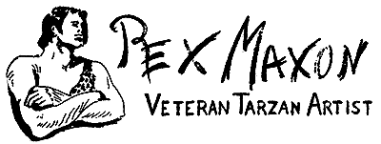
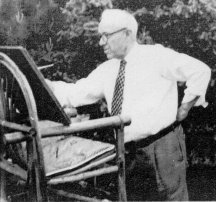
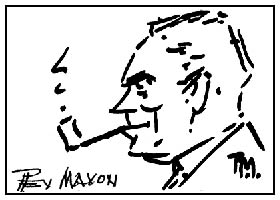


The ERB Artist Profile Series
REX HAYDEN MAXON
(1892-1973)



Harold Foster was the first artist to adapt Tarzan into strip form. It was actually a story strip, consisting of five panels a day with typeset text beneath each panel. Foster drew just 60 daily strips which were reprinted as one of the very first comic books (The Illustrated Tarzan Book No. I - G&D). When United Feature Syndicate, which commissioned the strip, decided to continue the daily Tarzan and Foster was unavailable, they turned instead to staff artist, Rex Maxon
Rex Hayden Maxon (1892-1973), son of a house painter, was born in Lincoln, Nebraska on March 24, 1892. When Rex was still a boy, his brother, Paul, and well-known artist-to-be, Clare Briggs, actually studied cartooning together. The Maxon family moved to Webster Groves, a suburb of St. Louis, Missouri. He spent much of his youth sketching the old river steamers on the Mississippi waterfront but his parents thought that one artist in the family was enough and encouraged him to become an electrical engineer. Rex stuck to his dream, however, and obtained a summer job during his high school years painting the river steamboats for the Government. He enrolled for private art lessons from J. LeBrun Jenkins and studied at the St. Louis School of Fine Arts. He later joined the staff of the St. Louis Republic newspaper. After a short period in Chicago, where he studied art at the Art Students League, worked as an idea man for a small ad ajency and did advertising art for the Lord and Thomas Agency. His first job there was drawing shoes for three dollars a week. Inspired by St. Louis Republic colleague Hazel Carter who had moved to New York to work for Evening World paper, he moved east in 1917. Here he lived with Arthur Button in a small studio on 37th Street where they nearly starved to death. He carved out a meagre existence selling theatrical and semi-comic newspaper features to the Evening Mail and later the New York Globe. Rex and Hazel jarried in 1920 and they worked together producing Carter-Maxon features for the New York Glove until it folded. They also did advertising and newspaper serial illustrations using real models for accuracy in their work. During this time Joseph Neebe of Famous Books and Plays, and Max Elser of Metropolitan National Syndicate, impressed with Maxon's experience in working with the human figure, contacted him to try out to carry on the daily Tarzan strip that had been started by Harold Foster. Foster had adapted Burroughs first Tarzan novel, Tarzan of the Apes in early 1929. 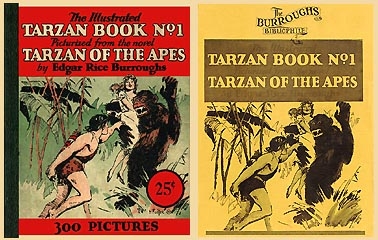
Illustrated Tarzan Book No. 1 ~ G&D & Tarzan of the Apes ~ House of Greystoke
Reprints of Hal Foster's adaptation of Tarzan of the ApesRex Maxon Arrives
Rex Maxon started the daily black and white Tarzan strip on June 10, 1929. Palmer, a writer in Cleveland, plotted out The Return of Tarzan and Rex did the first ten weeks for free. The strip was successful and was sold to United Features Syndicate. Maxon continued to draw the series, almost continuously, for the next 18 years -- a total of 5,200 strips. The adaptations were written by George Carlin and later by Don Garden. Rex took over the scripting during WWII, debuting with the a story involving bats flying out of a cave.
On March 15, 1931, the Tarzan colour Sunday page was inaugurated and Maxon took on this assignment as well. Unfortunately Foster was a hard act to follow. Maxon's inadequacies as an illustrator and storyteller, which may have been acceptable on a black-and-white daily strip, were magnified by the larger colour panels. Many thought him an odd choice as he lacked his predecessor's skill in figure drawing, composition, and several other abilities essential for the drawing of a jungle adventure strip. Edgar Rice Burroughs, especially, disliked Maxon's approach and complained frequently to the syndicate about the strip's art and story lines. He even suggested that Maxon be given photos of animals so he could learn to draw them correctly. Maxon, however, was kept on, possibly because he worked cheap.
In response to Burroughs' complaints, the syndicate brought back Harold Foster to take over the Tarzan colour Sunday pages -- giving Maxon more time to concentrate on the daily strips. This was the start of a very successful run that would stretch from September 27, 1931 through May 2, 1937. Foster then went on to even greater success with his own strip, Prince Valiant.
Between 1929 and 1947 Rex Maxon illustrated all but five of the 27 Tarzan story-strips that were published in newspapers. He continued the strip with original material when the story-strips finally caught up with ERB's output of novels. The Maxon image of Tarzan changed over the years. His original version of the apeman seemed to draw from James Pierce, as he appeared in Tarzan and the Golden Lion. He illustrated him as a handsome figure with short hair and a shoulder-draped leopard skin. Through the years, however, the progression of Tarzan's appearance reflected the public's changing tastes. A clever example of the change in the apeman is evident in Maxon's illustrations for the Tarzan the Untamed storyline. As the strip progressed his hair was shown a little longer each day and he became more savage looking. The draped leopard skin was replaced by a loin cloth. By the end of the story Tarzan had been modernized into the more graceful figure that would be used from then on except for a period in 1936 and 1937. Maxon quit over a pay dispute and William Juhre took over the strip until it started losing money and Rex was asked to return.
On August 28, 1939, the daily strip dropped its original four-panel format with text below and adopted the format still in use today. Most of these numbered daily strips have been reprinted in the English comic, Tarzan Adventures (This numbering started with matrix # 0001 and ran to #9999 by Russ Manning -- and ended with RM0308 / 10308)
Many of Maxon's Tarzan drawings have found their way into book form. Almost all of his early works were reprinted in the Whitman Big-Little and Better-Little Books, and some found their way into foreign hard covers such as TARZAN ET LES JOYAUX D'OPAR and TARZAN ET LA VILLE D'IVOIRE, Canadian editions published in French..
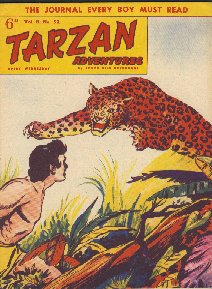
After leaving the Tarzan comic strip in 1947, Rex Maxon worked as a free lancer, mainly illustrating cowboy stories. His work can be found in Young Hawk, the secondary strip of Dell's Lone Ranger comicbook, throughout the 1950s. In 1954 Rex Maxon drew all the interior art for the first issue of Dell's Turok, Son of Stone. He evidently cooperated with editor Matt Murphy in creating the characters of Turok and Andar, and in formulating the prehistoric, Doylesque "Lost Word" that the Indian braves discover. After his contribution to that first issue, Maxon's appearances in Turok were sporatic. Most of the strips, during the comic's first years, were drawn by unsigned artists like Bob Correa, Ray Bailey, Bob Fujitani, and perhaps also Frank Bolle and Samuel J. Glanzman. Rex Maxon generally contributed a four-page "educational" filler strip on prehistoric beasts, entitled "Young Earth," but his work on the Turok strip itself was rarely published.
After Alberto Giolitti took over the Turok comic illustration duties in 1962, Rex Maxon occasionally supplemented the Italian artist's efforts by drawing the magazine's main story. A notable example may be seen in the issue for Sept.-Nov., 1962, where Maxon drew all the interior art, including the Young Earth strip. Whether this work was a contemporary contribution or a restrospective inclusion of earlier, previously unpublished Maxon art remains unclear. Maxon retired from drawing comics a few years prior to his death in 1973, but his work continued to appear in Turok throughout the late 1960s and into early 1970s. He and Hazel moved to London in 1969 where he did water colour painting and worked on portraits. His final years were spent with Hazel and their daughter, Jeanne, about 45 miles from New York, in Rockland County on the Hudson river.
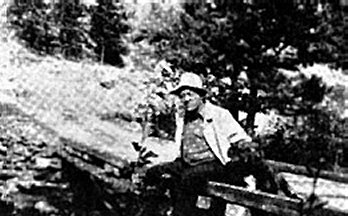
Rex Maxon relaxes on the bridge leading to his sister's cabin
in the South St.Urain Canyon in Colorado.
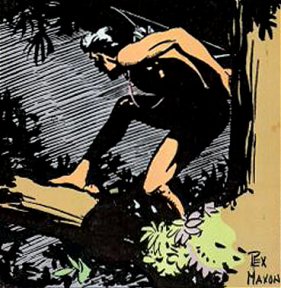
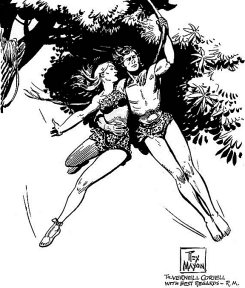
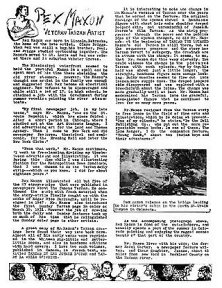
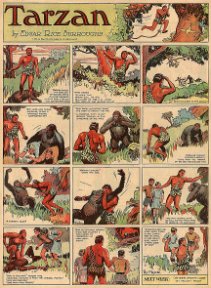
Rex Maxon's First Tarzan Sunday Page March 15, 1931 |
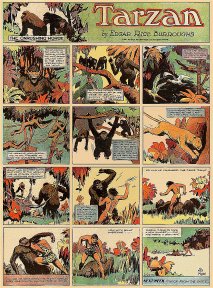
Rex Maxon's Last Tarzan Sunday Page September 20, 1931 |
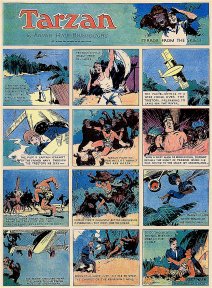
Transition to Hal Foster Art September 27, 1931 |
ERB was never really happy with Maxon's work on the Tarzan strips. We present here a sampling of the criticisms and comments regarding Maxon's work on his 32 Sunday pages of 1931.
Leopards climb trees. Change Sheeta to Sabor.
Luna should be Goro.
Change a giant crocodile to Gimla the crocodile.
Half-Nelson should be a full-Nelson.
Pineapple not native to Africa
Care should also be taken in these instructions to the artist to prevent illustrating or describing flora or fauna not native to Africa or to Equatorial Africa. I learned after the crisicisms were made of the first Tarzan story to be more careful and although I mentioned pineapples in the first book, I doubt if I did so thereafter and you might as well profit by my mistakes. Incidentally, I might say that I put a tiger in Africa in the magazine version of the first Tarzan story, though I was careful to yank him out of the book version before it went to press. I usually dodge the issue by using generic terms rather than describing fruits and nuts specifically. It was always safe to assume that edible fruits and nuts grow in the forests, but I try to be careful not to mention bananas or coconuts specifically, since I am not at all sure that they grow in central Equatorial Africa.
In Strip #1 Tarzan is described as a twelve year old boy and I find nothing in subsequent strips to suggest that any considerable time is supposed to have elapsed between the strips, nor is any reference made to his having attained manhood, yet in Strip #5 he fights successfully with a full grown bull-ape.
"That whenever a deer is used in Africa that it be changed to an antelope, as there are no deer in Africa. Bara the antelope can be substituted for the deer and this information should be passed on to the artist so that he will not draw a deer.
Another suggestion is that the third page story, instead of having those cannibal dwarfs occupy tents, it seems that they should occupy native huts.
Change the name Boreema to Muviro.
There is one matter, however, that I wish to call to your attention and which I feel quite guilty in having overlooked originally, my only excuse being that I have been far from well for a year or more and I guess my mind wasn't on my business when these strips were first suggested. I refer to the use of the children in the Sunday strip. What I should have called your attention to is the fact that the only Tarzan story tha I ever wrote which is a flop is a juvenile called The Tarzan Twins, written around two boys. My readers, adult as well as children, simply did not seem to want this type of story. The children seem to be going all righ, however, in the Sunday pages, but if you ever feel that they areslipping I suggest winding this up and starting on a new angle with adults, which could easily be done with these same two children or at least the girl, whom I presume is about twelve or fourteen yehars old, by leaving her mysteriously lost in the jungle and then picking her up two or four years later, as the case may be, at the age of sixteen or older. In any even, when we are through with these children in their youth I believe it would be wise to confine ourselves to adults in the future as the principal characters.
To be perfectly frank with you, however, I may explain that the thing that bothered me was the possible effect that the juvenile element in the color pages might have on my book sales. My stories are written for adults and while I have enjoyed a large and profitable juvenile following, I am constantly endeavoring to impress on the public that the stories are primarily stories for adults and I am afraid that these Sunday hcolor pages are going to pull some of the pegs out from under my contention. Inasmuch as the book and magazine popularity of my stories laid the foundation for the success of everything connected with Tarzan, including the strips, it might be well for you to bear this thought in mind and consider the advisability of aging the children a few years at least in the later strips. For all concerned it will be well worth serious consideration.
The rhinoceros is not a river animal. Some species frequent swampy land, but the black African rhinoceros is found on plains and in the foothills. I should change this panel to indicate that Buto crosses a for from the mainland to the island, or else make no mention of the river in this connection and change the panel. (He requested a panel caption to read: "To the keen ears of irritable Buto the rhinoceros come the sounds of the camp making."
He recommended a closing remark in page 16 to be the more heroic "We will take it with us."
When informed that there had been letters about the strip being short on humor and containing to many gory scenes ERB said: "Unfortunately, most of the success of the Tarzan stories appears to be the result of a human weakness for gory and gruesome situations. This is the first criticism of this nature that I have ever seen during nearly twenty years of Tarzan. I do, however, like the idea of using a little relief in some form, such as you suggest, but we must be careful not to get too much comedy into these pages."
What is your re-action to the idea of making this page appeal more to adults than to little children. I have always written my stories for adults and I have a very large adult following which has not kept the children from being even more interested in Tarzan than their parents. It just occurred to me that if we make the appeal in the Sunday page a little less to small children, we might be increasing our audience.
Tarzan dialogue for page 21: You threaten Tarzan, Lord of the Jungle?" demanded the ape-man coldly. "You might find that dangerous."
July: Ed complained that the page would be more popular if "Maxon would put more life, more action in his drawings. As they appear in the papers they are not typically Burroughs stuff, that is evident. My stories are full of action, whereas the picturized version of them, as drawn by Maxon, make them appear dull and listless. There seems to be no life in them."
In the August 23, 1931 page Ed had taken exception to the use of the lifeboat by Tarzan as a shield. Perhaps you will say that I, also, have had him do ridiculous things, but they have always been carefully thoughout and I have succeeded so far in making them seem within the range of possiblilities. Hoever, as I cannot visualize a steel lifeboat as being much less than sixteen feet long, which would be rather a small lifeboat at that, it would seem that we would be rather straining the credulity of the raders were we to show even Tarzan using such a heavy and cumbersome thing as a shield.
In the August 30 pageEd suggested that the crashing of the yacht could not possibly break the pirates' bonds without severely injuring them -- probably killing them. You might have one of the men get hold of a knife and hold it behind him in his bound hand, and then one of the others could back up against him and by rubbing his bonds upon the blade sever them. (already in print and unable to revise).
After numerous pages went to press without his suggested revisions being made, Ed's reaction was: I am returning outline of September 6th release of Tarzan page with my approval, which seems more or less unnecessary and rather a waste of time on my part inasmuch as I gather from your letter of July 28th that the work is all completed before these outlines are submitted to me. I wasted a week on Tarzan at the Earth's Core, sent to me by Joe Neebe, only to find out that the damned thing was in print before it was sent to me.
Ed rejected the continuity for page 29, panels 8-12. He rewrote the directions for the artist, called "Action," as well as all the panel captions.
Ed's ongoing displeasure with the Maxon Sunday page eventually resulted in change and Hal Foster was hired to take over the page on September 27, 1931 -- the start of a memorable three year run. Rex Maxon continued doing the Tarzan daily strip until 1947 (William Juhre did the strip from June 1936 through January 1938).
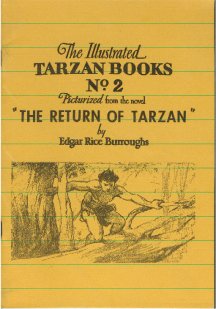
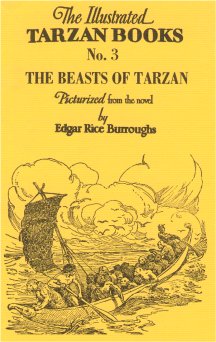
Rex Maxon adapted many of the ERB Tarzan titles to comic strip format,
which in turn were compiled into Whitman Big Little Book editions.
See the
ERB Big Little Book Illustrated Bibliographies
in
http://www.erbzine.com/mag0/0044b.html
http://www.erbzine.com/mag0/0044c.html
and in the
ERB
C.H.A.S.E.R. Illustrated Bibliography
also
The Comics
Emporium
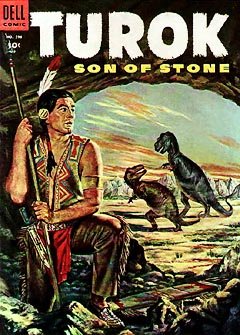
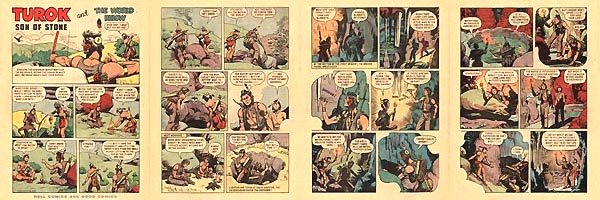
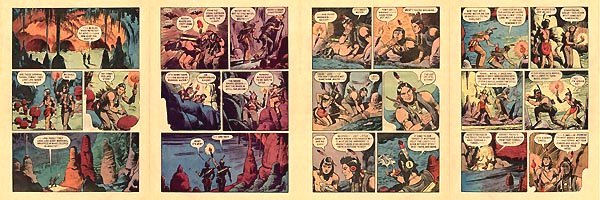
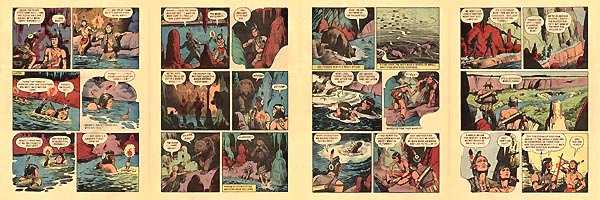
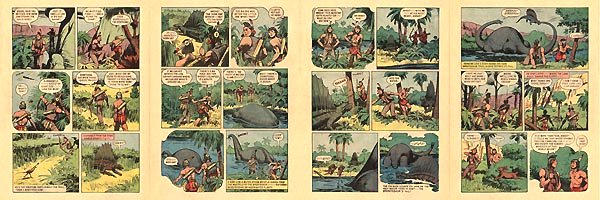

REFERENCES
The Dale Broadhurst Collection
http://www.lambiek.net/maxon_rex.htm
http://www.erbzine.com/mag0/0044a.html
http://cagle.slate.msn.com/hogan/issue1/reviews.asp
http://dlib.lib.ohio-state.edu/cga/pdfs/201-300/0296.30.pdf
THE
COMIC STRIP PROJECT
DREAM
VAULTS OF OPAR
Armstrong
Sperry and Maxon
http://www.erbzine.com/mag3/0358.html
http://escena.ya.com/tarzana54/tnovedad.html
http://www.unitedmedia.com/comics/tarzan/archive/
Maxon's First
Tarzan Sunday Page
ERB Foreign
Tarzan of the Funnies by Robert R. Barrett
Martin Sheridan, Comics and Their Creators, 1977, pp. 226, 236
P. Couperie & Maurice Horn, A History of the Comic Strip, 1967-68,
p. 131
Maurice Horn, World Encyclopedia of comics, 1976, pp. 486, 650
Comics Between the Panels - Steve Duin & Mike Richardson, 1998.
[p. 304]
The Great American Comic Strip - Judith O'Sullivan, 1990
The Encyclopedia of American Comics, Ron Goulart, editor, 1990 [pp.
255-256]
Vern Coriell's The Burroughs Bulletin #12, 1956
THE REX MAXON TRIBUTE PAGES IN ERBzine
www.ERBzine.com/maxon
|
|
|
|
|
|
|
|
|
|
![]()
![]()
Volume
0827
![]()

![]()
BILL
HILLMAN
Visit
our thousands of other sites at:
BILL
and SUE-ON HILLMAN ECLECTIC STUDIO
ERB
Text, ERB Images and Tarzan® are ©Edgar Rice Burroughs, Inc.-
All Rights Reserved.
All
Original Work ©1996-2006/2018 by Bill Hillman and/or Contributing
Authors/Owners
No
part of this web site may be reproduced without permission from the respective
owners.